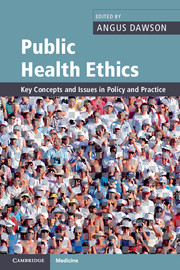4 - Risk and precaution
Published online by Cambridge University Press: 05 July 2011
Summary
Introduction
The concepts of risk and precaution are central to public health policy, and therefore to philosophical and ethical reflection on such policy. A wide range of public health activities – such as health and safety legislation, food standards monitoring and the emerging field of public health genomics – are explicitly framed in terms of risk-reduction and risk-management. Furthermore, we can use the concept of ‘risk’ to understand public health policies that are not normally framed in these terms. For example, draining a malarial swamp can be understood as eliminating health-risks, as can a policy of compulsory vaccination. The control, minimization or elimination of health-risks can, then, be seen as the shared concern of the heterogeneous activities that comprise public health policy.
Normally, we understand the reduction of risk as instrumentally valuable. That is to say, we view it as a tool for ensuring a particular distribution of health-outcomes (or, perhaps, a distribution of opportunities for health). Arguably, we might also view the reduction of risk as directly valuable, because living in an environment where risks of serious physical harm or suffering have been reduced is a constituent of what Amartya Sen (1992) calls our ‘capabilities’, our ‘real freedoms’ to achieve valuable functionings. Someone who lives in an environment in which malaria has been eradicated, for example, is not only less likely to suffer ill-health than someone who lives in a malarial environment, but may also be said to enjoy greater ‘positive freedom’; the range of activities she may reasonably choose to pursue is greater than the range of activities her counterpart can reasonably choose to pursue.
- Type
- Chapter
- Information
- Public Health EthicsKey Concepts and Issues in Policy and Practice, pp. 67 - 84Publisher: Cambridge University PressPrint publication year: 2011
References
- 2
- Cited by



